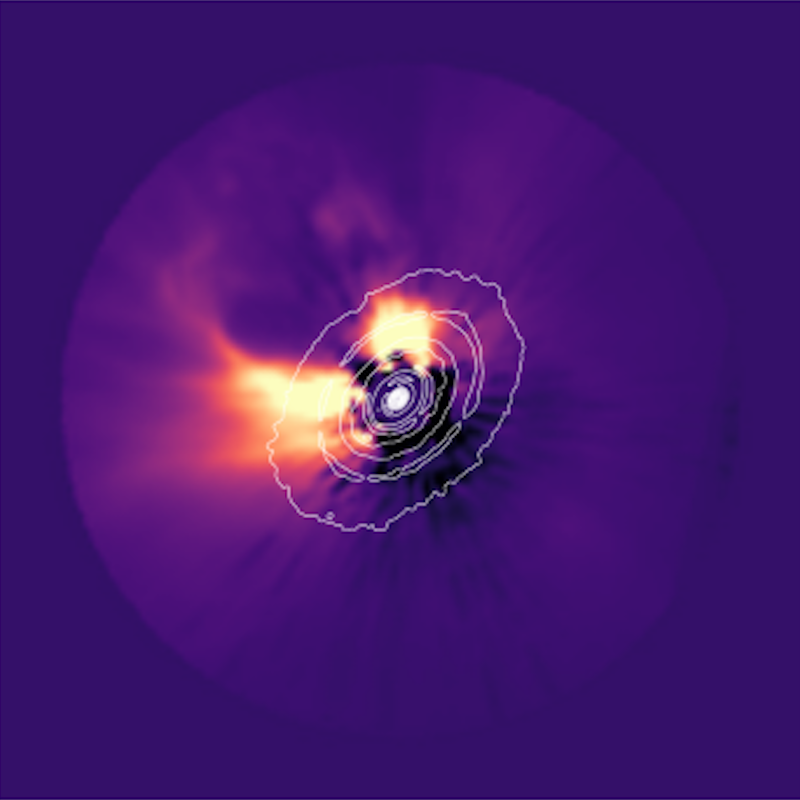
- The James Webb Space Telescope has now acquired images of three planet-forming disks. These are disks of gas and dust around young stars, where new planets might be forming.
- Webb didn’t see any baby planets in the disks. But, astronomers said, the planets might orbit too closely to their stars to be seen, even by Webb. Or they might be too faint.
- One astronomer said a particular disk – around the star HL Tau – “blew his mind.” He said he saw features of the disk resembling streams, clearly showing material flowing from the young star into the planet-forming disk.
Searching for baby planets in young planetary systems
Our own solar system – our sun and its family of planets – formed from a massive disk of gas and dust around the newborn sun. Likewise, astronomers have now seen and photographed many young planet-forming disks – called protoplanetary disks – over the years.
Recently, the James Webb Space Telescope obtained its first images and observations of three young protoplanetary disks. Researchers at the University of Arizona led the new observations. They said that Webb didn’t detect any actual forming planets, but that is likely because the disks are still too young or the fledgling planets are too faint to be seen, even with Webb.
The research team, led by Jarron Leisenring at the University of Arizona’s Steward Observatory, published three peer-reviewed papers in The Astrophysical Journal on March 27, 2024. You can read them here, here and here.
Two additional papers are also being written, but are not yet published.
3 protoplanetary systems
The 3rd paper details some of the most interesting findings that Webb made. Specifically, the paper focuses on a protoplanetary disk around the young star HL Tauri, or HL Tau, 457 light-years away. Like most protoplanetary disks in young planetary systems, this one has multiple rings of material in the disk.
Scientists first saw those rings using the Atacama Large Millimeter/submillimeter Array (ALMA) radio telescope in the Atacama Desert, Chile. And the gaps between the rings are where new planets might be developing.
Additionally, Webb observed the protoplanetary disk systems SAO 206462 and MWC 758, as discussed in the other two papers.
Planets or no planets?
So, do any of these protoplanetary disks have baby planets? In order to examine them in the most detail possible, the researchers combined the new Webb images with previous ones from the Hubble Space Telescope and ALMA. This enabled the astronomers to see new details of the interactions between the disks and the envelopes of gas and dust that surround the young stars.
The observations, ultimately, did not reveal the presence of any planets. But the researchers said there may be a couple of reasons for that.
Kevin Wagner, also at the University of Arizona’s Stewart Observatory, is a co-author on the HL Tau paper and lead author on the MWC 758 paper. He said:
The lack of planets detected in HL Tau, and really in all three systems, tells us that the planets causing the gaps and spiral arms either are too close to their host stars or too faint to be seen with JWST. If the latter is true, it tells us that they’re of relatively low mass, low temperature, enshrouded in dust or some combination of the three, as is likely the case in MWC 758.

Comparison with other young planetary systems containing planets
Leisenring added:
While there is a ton of evidence for ongoing planet formation, HL Tau is too young with too much intervening dust to see the planets directly. We have already begun looking at other young systems with known planets to help form a more complete picture.
New views of proto-stellar envelopes
Even though Webb didn’t see any planets, it did make other important findings. For example, it obtained unprecedented views of the proto-stellar envelope. This envelope is a collapsing cloud of gas and dust – separate from the larger planet-forming protoplanetary disk – directly shrouding the young star. The gas and dust are just beginning to coalesce together in the envelope.
This was particularly evident in the images of HL Tauri, Wagner said:
When I saw the JWST images of HL Tau, they just blew my mind. I was expecting to see the disk or the rings, or maybe some planets in the rings, but instead, what we see are these features of the proto-stellar envelope resembling streams, clearly showing material flowing into the protoplanetary disk.
Leisenring also commented on the streams, saying:
We see a very complex and dynamic system with ‘streamers’ feeding material from the outer envelope into the inner regions of the disk, where we expect planets to be forming.
Bottom line: NASA’s Webb space telescope looked for baby planets in the protoplanetary disks of three young planetary systems. It didn’t find any so far. Scientists explain why.
Sources:
Read more: 1st planet-forming disk found in another galaxy
Read more: Astonishing image of planet-forming disk from ALMA











